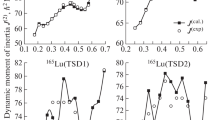Abstract
The current status of the ΔI=4 bifurcation in superdeformed bands is reviewed by making use of a theoretical model based on the interaction of rotation and single-particle nucleon motion in nuclei with an axial deformation. It is shown that the hexadecapole-type distortion of a nuclear shape by rotation is especially important for explaining the phenomenon. The necessary condition for staggering is obtained from an analysis of the nonadiabatic effect of rotation. This criterion is applied to 30 superdeformed bands in the mass region around A ∼ 150. An analysis confirms the configuration-dependence effect and allows us to discriminate between single-particle states active and inactive for staggering. The consideration is based on the additivity of the nonaxial hexadecapole moment, which plays a key role in the staggering phenomenon.
Similar content being viewed by others
References
L. K. Peker, S. Pearlstein, J. O. Rasmussen, and J. H. Hamilton, Phys. Rev. Lett. 50, 1749 (1983).
S. Flibotte et al., Phys. Rev. Lett. 71, 4299 (1993).
B. Cederwall et al., Phys. Rev. Lett. 72, 3150 (1994).
B. Cederwall et al., Phys. Lett. B 346, 244 (1995).
L. A. Bernstein et al., Phys. Rev. C 52, R1171 (1995).
A. T. Semple et al., Phys. Rev. Lett. 76, 3671 (1996).
G. de Angelis et al., Phys. Rev. C 53, 679 (1996).
S. M. Fischer et al., Phys. Rev. C 53, 2126 (1996).
I. Hamamoto and B. Mottelson, Phys. Lett. B 333, 294 (1994); Phys. Scr. T56, 27 (1995).
A. O. Macchiavelli et al., Phys. Rev. C 51, R1 (1995).
I. M. Pavlichenkov and S. Flibotte, Phys. Rev. C 51, R460 (1995).
K. Burzyński, P. Magierski, J. Dobaczewski, and W. Nazarewicz, Phys. Scr. T56, 228 (1995).
P. Magierski, K. Burzyński, and J. Dobaczewski, Acta Phys. Pol. B 26, 291 (1995).
I. N. Mikhailov and P. Quentin, Phys. Rev. Lett. 74, 3336 (1995).
Yang Sun, Jing-ye Zhang, and Mike Guidry, Phys. Rev. Lett. 75, 3398 (1995).
W. G. Harter, Comput. Phys. Rep. 8, 319 (1988).
I. Ragnarsson, Poster of the Conference on Physics from Large γ-Ray Detector Arrays, Berkeley, 1994.
W. D. Luo, A. Bouguettoucha, J. Dobaczewski, et al., Phys. Rev. C 52, 2989 (1995).
P. Magierski, P.-H. Heenen, and W. Nazarewicz, Phys. Rev. C 51, R2880 (1995).
F. Dönau, S. Frauendorf, and J. Meng, Phys. Lett. B 387, 667 (1996).
D. S. Haslip et al., Phys. Rev. Lett. 78, 3447 (1997).
B. Singh, R. B. Firestone, and S. Y. Frank Chu, Nucl. Data Sheets 78, 1 (1996).
D. S. Haslip, S. Flibotte, C. E. Svensson, and J. C. Waddington, Phys. Rev. C 58, R1893 (1998).
I. M. Pavlichenkov, Pis'ma Zh. Éksp. Teor. Fiz. 64, 231 (1996) [JETP Lett. 64, 252 (1996)].
I. M. Pavlichenkov, Phys. Rev. C 55, 1275 (1997).
I. M. Pavlichenkov, Pis'ma Zh. Éksp. Teor. Fiz. 66, 759 (1997) [JETP Lett. 66, 796 (1997)].
G. A. Lalazissis and K. Hara, Phys. Rev. C 58, 243 (1998).
D. S. Haslip et al., Phys. Rev. C 58, R2649 (1998).
Yu. T. Grin' and I. M. Pavlichenkov, Zh. Éksp. Teor. Fiz. 43, 465 (1962) [Sov. Phys. JETP 16, 333 (1963)].
I. M. Pavlichenkov, Nucl. Phys. 55, 225 (1964).
E. R. Marshalek, Phys. Rev. B 139, 770 (1965); 158, 993 (1967).
I. M. Pavlichenkov, Phys. Rep. 226, 175 (1993).
W. G. Harter and C. W. Patterson, J. Chem. Phys. 80, 4241 (1984).
I. M. Pavlichenkov, in Proceedings of the Conference on Physics from Large γ-Ray Detector Arrays, Berkeley, 1994, p. 14.
M. Baranger and K. Kumar, Nucl. Phys. A 110, 490 (1968).
I. Ragnarsson and P. B. Semmes, Hyperfine Interact. 43, 425 (1988).
B. Haas et al., Nucl. Phys. A 561, 251 (1993).
G. Hebbinghaus et al., Phys. Lett. B 240, 311 (1990).
W. Satula, J. Dobaczewski, J. Dudek, and W. Nazarewicz, Phys. Rev. Lett. 77, 5182 (1996).
A. B. Migdal, Nucl. Phys. 13, 655 (1959).
H. Sakamoto and T. Kishimoto, Nucl. Phys. A 501, 205 (1989).
I. M. Pavlichenkov, Pis'ma Zh. Éksp. Teor. Fiz. 71, 8 (2000) [JETP Lett. 71, 4 (2000)].
Y. R. Shimizu, Nucl. Phys. A 520, 477c (1990).
Ch. Theiseh et al., Phys. Rev. C 54, 2910 (1996).
H. Savajols et al., Phys. Rev. Lett. 76, 4480 (1996).
I. Ragnarsson, private communication.
S. Flibotte et al., Nucl. Phys. A 584, 373 (1995).
W. Nazarewicz and I. Ragnarsson, in Handbook of Nuclear Properties, Ed. by D. Poenaru and W. Greiner (Clarendon Press, Oxford, 1996), p. 80.
G. de France et al., Phys. Lett. B 331, 290 (1994).
L. B. Karlsson, I. Ragnarsson, and S. Åberg, Nucl. Phys. A 639, 654 (1998).
L. B. Karlsson, Doctoral Dissertation (Lund Univ., 1999).
Author information
Authors and Affiliations
Additional information
From Yadernaya Fizika, Vol. 64, No. 4, 2001, pp. 653–668.
Original English Text Copyright © 2001 by Pavlichenkov, Shchurenkov.
This article was submitted by the authors in English.
Rights and permissions
About this article
Cite this article
Pavlichenkov, I.M., Shchurenkov, A.A. Microscopic approach to transition-energy staggering in superdeformed bands. Phys. Atom. Nuclei 64, 595–610 (2001). https://doi.org/10.1134/1.1368218
Received:
Issue Date:
DOI: https://doi.org/10.1134/1.1368218



